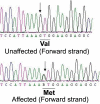Novel mutation in the gamma-S crystallin gene causing autosomal dominant cataract
- PMID: 19262743
- PMCID: PMC2650718
Novel mutation in the gamma-S crystallin gene causing autosomal dominant cataract
Abstract
Purpose: To identify the underlying genetic defect in a north Indian family with seven members in three-generations affected with bilateral congenital cataract.
Methods: Detailed family history and clinical data were recorded. Linkage analysis using fluorescently labeled microsatellite markers for the already known candidate gene loci was performed in combination with mutation screening by bidirectional sequencing.
Results: Affected individuals had bilateral congenital cataract. Cataract was of opalescent type with the central nuclear region denser than the periphery. Linkage was excluded for the known cataract candidate gene loci at 1p34-36, 1q21-25 (gap junction protein, alpha 8 [GJA8]), 2q33-36 (crystallin, gamma A [CRYGA], crystallin, gamma B [CRYGB], crystallin, gamma C [CRYGC], crystallin, gamma D [CRYGD], crystallin, beta A2 [CRYBA2]), 3q21-22 (beaded filament structural protein 2, phakinin [BFSP2]), 12q12-14 (aquaporin 0 [AQP0]), 13q11-13 (gap junction protein, alpha 3 [GJA3]), 15q21-22, 16q22-23 (v-maf musculoaponeurotic fibrosarcoma oncogene homolog [MAF], heat shock transcription factor 4 [HSF4]), 17q11-12 (crystallin, beta A1 [CRYBA1]), 17q24, 21q22.3 (crystallin, alpha A [CRYAA]), and 22q11.2 (crystallin, beta B1 [CRYBB1], crystallin, beta B2 [CRYBB2], crystallin, beta B3 [CRYBB3], crystallin, beta A4 [CRYBA4]). Crystallin, alpha B (CRYAB) at chromosome 11q23-24 was excluded by sequence analysis. However, sequencing the candidate gene, crystallin, gamma S (CRYGS), at chromosome 3q26.3-qter showed a heterozygous c.176G-->A change that resulted in the replacement of a structurally highly conserved valine by methionine at codon 42 (p.V42M). This sequence change was not observed in unaffected family members or in the 100 ethnically matched controls.
Conclusions: We report a novel missense mutation, p.V42M, in CRYGS associated with bilateral congenital cataract in a family of Indian origin. This is the third report of a mutation in this exceptional member of the beta-/gamma-crystallin superfamily and further substantiates the genetic and clinical heterogeneity of autosomal dominant cataract.
Figures




Similar articles
-
Mutation analysis of 12 genes in Chinese families with congenital cataracts.Mol Vis. 2011;17:2197-206. Epub 2011 Aug 16. Mol Vis. 2011. PMID: 21866213 Free PMC article.
-
A missense mutation in CRYGD linked with autosomal dominant congenital cataract of aculeiform type.Mol Cell Biochem. 2012 Sep;368(1-2):167-72. doi: 10.1007/s11010-012-1355-2. Epub 2012 Jun 6. Mol Cell Biochem. 2012. PMID: 22669729 Clinical Trial.
-
A novel human CRYGD mutation in a juvenile autosomal dominant cataract.Mol Vis. 2010 May 22;16:887-96. Mol Vis. 2010. PMID: 20508808 Free PMC article.
-
[Progress in pathogenic genes and their functions of congenital cataract].Zhonghua Yan Ke Za Zhi. 2010 Mar;46(3):280-4. Zhonghua Yan Ke Za Zhi. 2010. PMID: 20450675 Review. Chinese.
-
Genetics of crystallins: cataract and beyond.Exp Eye Res. 2009 Feb;88(2):173-89. doi: 10.1016/j.exer.2008.10.011. Epub 2008 Nov 1. Exp Eye Res. 2009. PMID: 19007775 Review.
Cited by
-
Structural analysis of the mutant protein D26G of human γS-crystallin, associated with Coppock cataract.Mol Vis. 2013 Jun 5;19:1231-7. Print 2013. Mol Vis. 2013. PMID: 23761725 Free PMC article.
-
The mutation V42M distorts the compact packing of the human gamma-S-crystallin molecule, resulting in congenital cataract.PLoS One. 2012;7(12):e51401. doi: 10.1371/journal.pone.0051401. Epub 2012 Dec 21. PLoS One. 2012. PMID: 23284690 Free PMC article.
-
Mutation analysis of 12 genes in Chinese families with congenital cataracts.Mol Vis. 2011;17:2197-206. Epub 2011 Aug 16. Mol Vis. 2011. PMID: 21866213 Free PMC article.
-
The cataract-associated V41M mutant of human γS-crystallin shows specific structural changes that directly enhance local surface hydrophobicity.Biochem Biophys Res Commun. 2014 Jan 3;443(1):110-4. doi: 10.1016/j.bbrc.2013.11.073. Epub 2013 Nov 25. Biochem Biophys Res Commun. 2014. PMID: 24287181 Free PMC article.
-
Rapid and cost-effective molecular diagnosis using exome sequencing of one proband with autosomal dominant congenital cataract.Eye (Lond). 2014 Dec;28(12):1511-6. doi: 10.1038/eye.2014.158. Epub 2014 Oct 10. Eye (Lond). 2014. PMID: 25301372 Free PMC article.
References
-
- Reese PD, Tuck-Muller CM, Maumenee IH. Autosomal dominant congenital cataract associated with chromosomal translocation [t(3;4)(p26.2;p15)]. Arch Ophthalmol. 1987;105:1382–4. - PubMed
-
- Vanita, Singh JR, Singh D. Genetic and segregation analysis of congenital cataract in the Indian population. Clin Genet. 1999;56:389–93. - PubMed
-
- Amaya L, Taylor D, Russell-Eggitt I, Nischal KK, Lengyel D. The morphology and natural history of childhood cataracts. Surv Ophthalmol. 2003;48:125–44. - PubMed
-
- Vanita V, Singh D, Robinson PN, Sperling K, Singh JR. A novel mutation in the DNA-binding domain of MAF at 16q23.1 associated with autosomal dominant “cerulean cataract” in an Indian family. Am J Med Genet A. 2006;140:558–66. - PubMed
Publication types
MeSH terms
Substances
LinkOut - more resources
Full Text Sources
Medical
Research Materials
Miscellaneous
